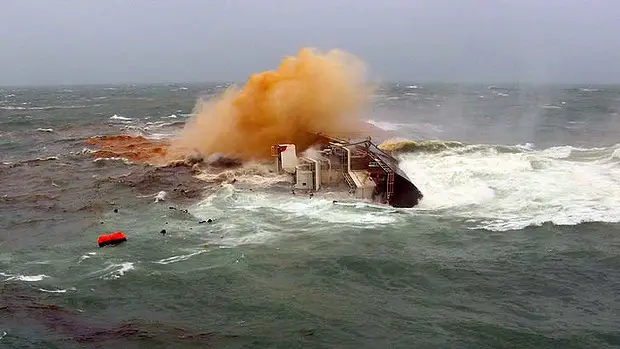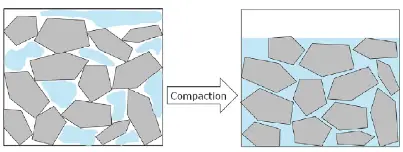The phenomenon of dry bulk cargo liquefaction is now receiving much attention from industry stakeholders because it has now been recognized as a major hazard for bulk carriers. Liquefaction is an interplay between Transportable Moisture Limit (TML) and Flow Moisture Point (FMP).
The IMO’s International Maritime Solid Bulk Goods Code (IMSBC) now provides recommendations on liquefiable goods and sampling, testing, and control procedures for such potentially life-threatening cargoes. So what then is Transportable Moisture Limit (TML) and Flow Moisture Point (FMP)?
The Transportable Moisture Limit is the maximum moisture content of a cargo that is safe for transportation on ships. The Flow Moisture Point is the percentage moisture content at which a flow state develops under the prescribed method of test in a representative sample of the material.

Liquefaction is the transformation of solid material into a nearly fluid state. Many common materials, including iron ore, nickel ore, and various mineral concentrates, can liquefy. The most serious consequence of liquefaction for a vessel is cargo shift, which leads to loss of stability.
This can cause dangerous angles of the list, and sometimes, the resulting loss of stability can be catastrophic, resulting in the loss of the vessel and the lives of those on board. It is therefore critical that seafarers be made aware of the cargo types and conditions that may cause liquefaction.

The Physics Of Liquefaction.
Solid bulk cargo is defined as any cargo that is transported in a loose form without any packaging. The IMO defines these as:
Solid bulk cargo means any cargo, other than a liquid or a gas, consisting of a combination of particles, granules or any larger pieces of material generally uniform in composition which is loaded directly into the cargo spaces of a ship without any intermediate form of containment.
IMSBC Code – International Maritime Solid Bulk Cargoes Code – Resolution MSC.268(85)
The mechanism of liquefaction is that in fine-grained moisture-laden cargo, the spaces between cargo grains are filled with both air and water. Whilst at sea, the cargo is subjected to forces because of the vibration and rolling of the vessel. These forces cause the inter-grain spaces to contract.
The water in the spaces between grains comes under a compressive force, but since it is a liquid, it cannot be compressed. This has the effect of lowering the inter-grain frictional force that keeps the cargo in a solid state.
If enough moisture is present, the reduction in inter-grain friction caused by the ship’s movement and vibration can make the cargo flow like a liquid, meaning it will liquefy.

DNV-GL one of the world’s leading classification societies has also noted certain specific and worrying characteristics of cargo liquefaction-related accidents. According to the article, such mishaps typically occur swiftly.
The interval between when liquefaction is noticed, if it is detected at all, and when the vessel capsizes might be as short as a few minutes, leaving very little time for remedial procedures and safe evacuation of the ship. As a result, these mishaps are frequently linked to the unfortunate deaths of a greater number of crew members.
Secondly, it has been observed that an accident on one vessel is often followed by a new accident, or near-accident, on other vessels that have loaded similar cargo at terminals in the same area. The report gave an example of the loss of the bulk carriers Jian Fu Star, Nasco Diamond, and Hong Wei, which occurred during a six-week period in the rainy season of autumn 2010, with all of them carrying nickel ore from Indonesia.
The table below lists ships of more than 10,000 tons of deadweight tonnage, (DWT) lost since 2009 where it is suspected that cargo liquefaction was the cause of the casualty.
| Vessel | Cargo type | Lives lost | Deadweight | Year Built | Accident Date | Cargo origin |
| Asian Forest | Iron ore fines | 0 | 14k | 2007 | Jul 17th, 2009 | India |
| Black Rose | Iron ore fines | 1 | 39k | 1977 | Sep 9th, 2009 | India |
| Jian Fu Star | Nickel ore | 13 | 45k | 1983 | Oct 27th, 2010 | Indonesia |
| Nasco Diamond | Nickel ore | 21 | 57k | 2009 | Nov 10th, 2010 | Indonesia |
| Hong Wei | Nickel ore | 10 | 50k | 2001 | Dec 3rd, 2010 | Indonesia |
| Vinalines Queen | Nickel ore | 22 | 56k | 2005 | Dec 25th, 2011 | Philippines |
| Sun Spirits | Iron ore fines | 0 | 11k | 2007 | Jan 22nd, 2012 | Philippines |
| Harita Bauxite | Nickel ore | 15 | 50k | 1983 | Feb 16th, 2013 | Indonesia |
| Trans Summer | Nickel ore | 0 | 57k | 2012 | Aug 14th, 2013 | Philippines |
Transportable Moisture Limit (TML)
As per the provisions of the International Maritime Solid Bulk Goods Code, the shipper is responsible for establishing the moisture level of their cargo to ensure safety, as well as creating procedures for sampling and moisture testing.
Prior to loading, the shipper must submit all relevant cargo information to the captain of the bulk carrier, including which group the cargo belongs to, and the TML of the cargo, which is the key parameter in assessing if the cargo is considered safe for carriage and the moisture content of the material to be loaded.
This is stipulated in IMSBC Code section 4.2. The competent authorities of the load port must approve all these procedures. A copy of the approval document should be provided to the master.
In the IMSBC Code, cargoes have been divided into three groups:
- Group A consists of cargoes that may liquefy,
- Group B are cargoes with chemical hazard and
- Group C cargoes are neither liable to liquefy nor to possess chemical hazards.
TML is therefore the maximum moisture content of a cargo that is considered safe for transportation in ships. If the cargo is assessed as having higher actual moisture content than its TML, then IMSBC Code does not allow the cargo should be loaded and transported by sea unless the vessel is specially built or fitted for confining cargo shift.
Flow Moisture Point (FMP)
The percentage of a typical sample that comprises water, ice, or another liquid, expressed as a percentage of the total wet mass of that sample, is called Moisture Content.
Moisture migration is defined as the movement, settling, and consolidation of moisture contained in cargo that occurs in the cargo during the ship’s voyage due to ship motions and vibrations. Water is gradually displaced, resulting in the development of a flow condition in some or all of the cargo.
Flow State
When a mass of granular material under the influence of external forces such as vibration, impaction, or ship motion becomes saturated with liquid to the point where it loses its internal shear strength and acts like a liquid it is said to have reached the Flow Moisture Point (FMP).
The Flow Moisture Point is therefore the percentage moisture content (wet mass basis) at which a flow condition arises in a representative sample of the material under the stipulated method of test.
Conclusion
In recent years, the liquefaction of iron ore and nickel ore cargoes, which are regularly provided for loading in dangerous conditions, has been blamed for a number of disasters in the shipping sector. Loading such cargo in a hazardous manner can have disastrous effects.
Nickel ore has been dubbed “The Deadliest Cargo” because, despite accounting for only 0.06 percent of global trade, it has caused 80 percent of deaths at sea since 2010. The UK P&I Club has advised its members to load liquefiable goods to follow the guidelines below.
- Ensure the shipper has supplied the required cargo information, including the TML and the actual moisture content in advance of loading.
- Carefully check the shipper’s cargo declaration and stated moisture content
- Consider appointing a surveyor in advance of loading to check the stockpile, take samples and arrange tests prior to loading
- Try to obtain access to lab testing if possible
- Only accept the cargo if the actual moisture content is less than its TML
- Carry out visual monitoring during loading. If there are any indications of high moisture content (surface water, cargo splatter on bulkheads, and so on), stop loading and seek further advice
- Consider trimming the cargo to reduce the likelihood of cargo shift as required by the IMSBC Code (that is when there is a risk of a wet base developing)
- Take measures to prevent water or other liquids from entering the cargo space during loading (and throughout the voyage) e.g. hatch cover tightness
- Conduct can-tests of samples at regular intervals at loading.
- Types of Gas Carriers as per IGC Code – April 22, 2025
- Wind-Assisted Propulsion Systems (WAPS): A Game Changer for Maritime Decarbonization – February 6, 2025
- 10 Boat Salvage Yards in California – January 25, 2025





Leave a Reply